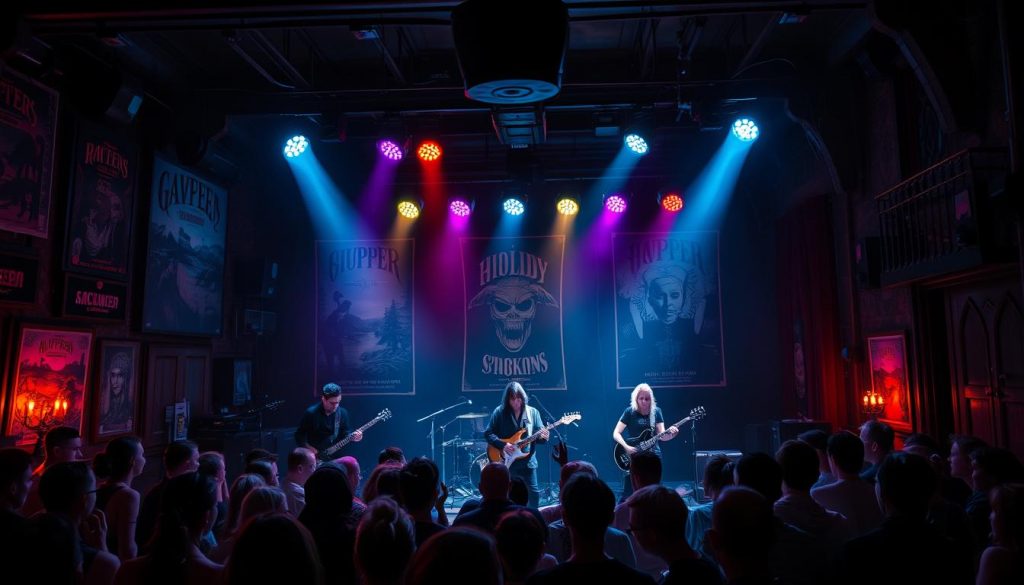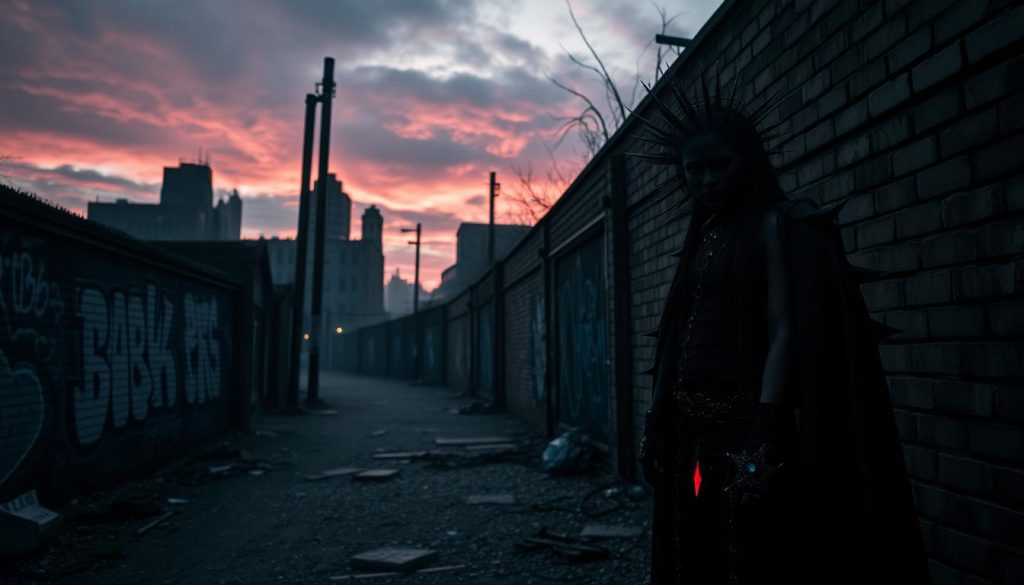The Goth Subculture: Dark Fashion and Rebellion in Modern Society
The goth subculture is a captivating mix of dark fashion and rebellion. It thrives in today’s society. It’s known for its love of the macabre and unique self-expression.
Anúncios
People show their true selves through bold styles, often in black. This movement is more than just fashion. It’s a powerful counter-culture that connects with music, literature, and art. It started in the 18th century and has grown into a modern art form.
This subculture shows a deep rebellion against mainstream values. As we dive into this world, we see that dark themes are more than a trend. They are a deep way of self-expression for many.
The goth community is a place of belonging. It’s where people find friends who understand their feelings of isolation. Let’s explore the origins, influences, and traits of the goth subculture together.
Introduction to the Goth Subculture
The goth subculture is a welcoming place for people to explore darker themes and themselves. It’s a unique space that shows the importance and essence of goth identity. Starting in the late 1970s, it combines music, fashion, and art for a vibrant self-expression.
Anúncios
Early goth music was shaped by punk and post-punk, with bands like Siouxsie and the Banshees and Joy Division. The single “Bela Lugosi’s Dead” by Bauhaus in 1979 was a key moment. By 2020, goth music had grown, with influences from electronic dance music, leading to sub-genres like Industrial and Synth Wave.
Fashion is just as key in the goth subculture. Early fans used different materials to create their unique looks. Today, styles include corsets and heavy boots, with a mix of Victorian and casual looks. This shows the subculture’s value as a place for creative self-expression.
- Goth music: It has grown from punk roots to include many styles.
- Cultural importance: Events like the Whitby Goth Weekend celebrate goth culture and community.
- Self-identity: Many find a sense of belonging and safety in the goth scene, building lasting relationships.
The goth subculture keeps growing, staying relevant over the years. It welcomes newcomers to explore their identities in its rich cultural world.
The Origins of Goth Fashion
Goth fashion started in the late 1970s and early 1980s. It came from the post-punk scene. Bands like Bauhaus were key, especially with “Bela Lugosi’s Dead,” seen as the goth rock’s start.
The style mixed Victorian and Edwardian looks with punk. It’s known for dark clothes, bold makeup, and a sad vibe.
Gothic literature was a big influence. Authors like Edgar Allan Poe and Bram Stoker added to the dark themes. The Romanticism movement also shaped goth beauty and sadness.
| Influence | Details |
|---|---|
| Gothic Literature | Contributed significantly with themes of horror and tragedy, shaping the aesthetics of goth fashion. |
| Victorian & Edwardian Eras | Provided inspiration for silhouettes, fabrics, and overall dark romanticism in fashion. |
| Punk Movement | Offered a rebellious spirit and DIY ethos, reflected in the customization of goth attire. |
| Music | Defined goth culture, with pivotal bands influencing both style and community identity. |
| Horror Cinema | Figures like Theda Bara showcased early dark aesthetics that inspired goth fashion trends. |
Goth fashion’s roots come from these influences. It shows the depth of the 1980s goth movement. Today, goth style is still a big part of fashion and culture.
Influences of Music Culture on the Goth Movement
The goth movement’s evolution is deeply connected to its music culture. It started in the late 1970s and early 1980s. Bands like Bauhaus, Siouxsie and the Banshees, and The Cure created a unique sound. Their music was filled with haunting melodies and deep lyrics.
This sound deeply influenced the goth music scene. It set the stage for future artists. It was more than just music; it was a way of life.
Gothic rock was shaped by artists like Iggy Pop and David Bowie. They added a sense of danger and rebellion. This sound has influenced many genres, including metal and electronic music.
Artists like Type O Negative and Depeche Mode show clear goth influences. Their music stands out in the music world.
The goth movement has spread globally. Events like the Wave-Gotik-Treffen festival in Germany attract fans worldwide. It showcases the diversity of the subculture.
Adaptations of goth fashion vary across the world. From Japan’s “Elegant Gothic Lolita” to Latin America’s darker styles, each region adds its own twist. Yet, they all stay true to the core of gothic rock.
Goth music’s unique sound is often overlooked. It faced limited airplay in the U.S. early on. This led to misconceptions and marketing issues that hid its true essence.
As interest in goth music grows, its impact on music culture becomes clearer. It has influenced fashion and other art forms. This shows the genre’s lasting impact.

Iconic figures in goth music have shaped its identity. They have brought attention to dark themes and a rebellious spirit. For more on the history of goth rock, check out this article on the history of goth rock.
Characteristics of Gothic Fashion
Gothic fashion is a mix of influences and styles that stand out. It focuses on dark clothes, with black being the main color. Silver adds to the mystery. Corsets, lace, and leather are key, along with heavy jewelry that shows occult symbols.
Gothic fashion is all about being different and expressing yourself. People like Siouxsie Sioux and Robert Smith are big names in this world. They show how music shapes fashion. Piercings and tattoos are big in goth fashion, telling personal stories.
Today, we see new styles like Pastel Goth and Cybergoth. These add colors to the usual dark look. Gothic fashion has grown, keeping its punk roots alive. It’s now seen in high fashion and modern styles, still embracing the dark.
Dark Themes in Goth Literature and Art
The goth subculture finds inspiration in dark literature and art. Writers like Edgar Allan Poe, Mary Shelley, and Lord Byron have shaped gothic literature. Their works, filled with melancholy and existential dread, match the visuals of goth art.
Gothic art uses grotesque images to show the harsh realities of life. It finds beauty in darkness, making viewers think about life and death. Characters from Gothic novels, like Lucy Westenra, have influenced goth fashion, adding to its melancholic elegance.
Musical influences also connect gothic literature to the goth movement. Bands like Bauhaus and Siouxsie and the Banshees use horror and the supernatural in their music. Songs like “Stranger Than Fiction” and “Dead Souls” reflect the alienation found in Gothic stories. The Cure’s “Charlotte Sometimes” directly takes inspiration from literature.
This mix of literature and art creates a rich tapestry of dark themes. It shows how goth culture celebrates isolation, the grotesque, and fascination with the macabre. These elements shape goth style and encourage deep discussions about the human experience.
| Key Elements | Gothic Literature | Themes in Goth Art |
|---|---|---|
| Influential Authors | Edgar Allan Poe, Mary Shelley, Lord Byron | Macabre Imagery, Grotesque Forms |
| Common Themes | Isolation, Existential Dread | Beauty in Darkness, Human Condition |
| Key Characters | Lucy Westenra, Frankenstein’s Monster | Symbolic Representations of Mortality |
| Musical Influence | Bauhaus, Siouxsie and the Banshees | Integrating Literary Themes into Music |
| Visual Aesthetics | Victorian Styles, Dark Romanticism | Corsets, Lace, Dramatic Elements |
The Role of Rebellion in the Goth Subculture
The goth subculture started about 40 years ago. It began as a rebellion against mainstream culture. People in this movement reject typical beauty, morality, and social norms.
This rebellion shows in fashion and music. It also creates a sense of belonging for those who don’t fit in.
Cultural symbols in the goth community are key. They wear dark clothes, unique accessories, and bold hairstyles. This visual language signals their dissent.
These styles reflect a deeper critique of society. They challenge the status quo, as Dick Hebdige points out.
The goth culture loves themes like death and decay. It draws inspiration from Edgar Allan Poe and Mary Shelley. This shows a different view of life and beauty.
Goth music, starting with post-punk, is a powerful form of rebellion. Artists like Marilyn Manson mix styles to challenge consumerism. Their music evolves, keeping the critique alive.
Social media has made goth culture more visible worldwide. It connects people who reject mainstream norms. This allows for passionate celebration of nonconformity.

Goth Culture Across the Globe
Goth culture is alive and thriving worldwide, with communities in every corner. This diversity lets the culture grow and change in new ways. For instance, Japan’s “Elegant Gothic Lolita” fashion is a unique mix of Victorian and gothic styles.
Germany is known for its big goth festivals, like Wave-Gotik-Treffen. These events bring people together, celebrating the rich goth culture. Music also plays a big role, with bands like Type O Negative and Depeche Mode adding to the scene.
Exhibitions like “Gothic: Dark Glamour” at The Museum at FIT show goth’s importance in art and fashion. Designers like Alexander McQueen and Rick Owens bring goth into high fashion. This makes goth more popular in luxury fashion.
The art world loves dark romanticism, showing goth’s influence. Authors like Neil Gaiman and Anne Rice also draw from goth themes. This keeps goth culture fresh and exciting, always evolving.
Goth Influences in Modern Fashion and Pop Culture
Goth influences have deeply shaped modern fashion and pop culture. In recent years, gothic styles have become more visible on high-fashion runways. Designers like Alexander McQueen and Rick Owens have led this trend, adding gothic touches to their designs.
Today, fashion often features dark colors, dramatic shapes, and romantic styles. About 60% of fashion designers now find inspiration in gothic themes. This shift shows that goth aesthetics are now widely accepted in culture. Major exhibitions, like “Gothic: Dark Glamour,” show how goth influences connect with modern art.
In music, around 40% of alternative tracks today have gothic sounds and images. Artists like Billie Eilish use dark themes to connect with young fans. This shows how goth influences are becoming more mainstream.
Goth culture is also growing globally. Festivals like Wave-Gotik-Treffen in Germany have seen a 30% increase in attendees. In Japan, “Elegant Gothic Lolita” fashion combines Victorian and gothic styles, showing a unique take on the culture.
Literature and performance art have also welcomed gothic themes. There’s been a 35% rise in modern Gothic novels and about 50% of performance art now uses these themes. The gothic look has even influenced home decor, with a 45% increase in requests for gothic-inspired designs.
Conclusion
The goth subculture is all about being different and standing out. It mixes dark fashion with a love for music and art. This creates a world of self-expression that touches lives everywhere.
This culture lets people be creative and challenge the usual ways of thinking. It encourages a fresh way of living.
The goth movement has left a mark on today’s fashion, art, and music. You can see goth styles in modern trends. It shows that being true to oneself is powerful.
Looking back, we see how goth culture has grown but stayed true to its roots. It values acceptance and being different.
In the end, the goth subculture teaches us about the power of self-expression. It’s more than just style; it’s a community that celebrates diversity and passion. Goths inspire and empower others, showing that true creativity never fades.
